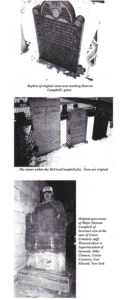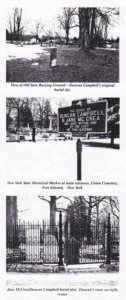by William S. Burke, Commissioner, Region 2, Clan Campbell Society (NA)
(From the Journal of the Clan Campbell Society – North America, Vol. 39 No. 2, Spring 2012)
You would certainly have heard before now of poor Major Duncan Campbell of Inverawe’s death …. 1
So ends, or perhaps begins, the remarkable story of a Scot who, under other circumstances, may never have been more than a footnote in the history of the engagement between the French and British Forced on July 7-8, 1758, at the Battle of Ticonderoga (or Carillon). However, many of us being familiar with the legend of Duncan Campbell of Inverawe, are determined that the legend will live and prosper to a point that, even at this writing, Major Campbell’s demise continues to be a topic of current historical interest. 2
After Major Duncan Campbell died on July 17, 1758, at the King’s Hospital on Roger’s Island at Fort Edward, NY, his remains were interred in the Old State Burying Ground to the east above the Hudson River in an area reserved for Officers.3 He remained at rest there until he was disinterred and moved to what was then known as Sandy Hill Cemetery and buried in the Gilchrist family plot where his body remained until 1922. From the beginning, Major Campbell’s grave was marked by a well-crafted red sandstone monument. On its face was the following inscription:
“Here lyes the body of Duncan Campbell of Inversawe(sic), Esq., Major to the old Highland Regt., aged 55 years who died the 17th July, 1758 of the wounds he received in the attacks of the retrenchments of Ticonderoga or Carillon the 8th July 1758.”
There has been some interesting speculation about the origins of Duncan’s gravestone itself, as there is some vague mention of the marker originating in Scotland.4 However, given the geology of North Britain, this would seem unlikely given that this type of sandstone is not native to Scotland and the  impracticality of transporting tombstone material that was readily available in the area under discussion. The stone was certainly fashioned from the abundant local Potsdam sandstone readily available in this part of northeastern New York State. Indeed, Professor Richard Lindemann, of the Skidmore College geology department, Saratoga Springs, NY has affirmed that Duncan’s original stone is of Potsdam origin. Further speculation is that the stone was carved in New York City, as numerous headstones of a style similar to that of Duncan’s are still standing in the old burial grounds within that city’s limits. Nonetheless, there is no reason to believe that there weren’t local craftsmen, perhaps even of Scottish origin, who could have produced such a headstone. Numerous examples of this type of headstone can be found locally.5
impracticality of transporting tombstone material that was readily available in the area under discussion. The stone was certainly fashioned from the abundant local Potsdam sandstone readily available in this part of northeastern New York State. Indeed, Professor Richard Lindemann, of the Skidmore College geology department, Saratoga Springs, NY has affirmed that Duncan’s original stone is of Potsdam origin. Further speculation is that the stone was carved in New York City, as numerous headstones of a style similar to that of Duncan’s are still standing in the old burial grounds within that city’s limits. Nonetheless, there is no reason to believe that there weren’t local craftsmen, perhaps even of Scottish origin, who could have produced such a headstone. Numerous examples of this type of headstone can be found locally.5
Duncan’s first disinterment and reburial in the Gilchrist family plot in what was then Sandy Hill and Fort Edward Union Cemetery was apparently at the behest of the Gilchrists, a local family who claimed to be blood relatives of his. However, there is no proof of such a relationship. The Gilchrists likely claimed a relationship to Laughlan Campbell, the holder of the original Argyle patent in Washington County, NY, as support for their conclusion that they were related to Duncan. This mystery remains subject to speculation although the writer is informed by Major Campbell’s direct descendant, Diarmid Campbell, of Kilmelford, Argyll, Scotland, and editor emeritus of [the Journal of the Clan Campbell Society (North America)], that there is no known documentation of any blood connection between Major Duncan Campbell of Inverawe and the Gilchrists of Washington County. Certainly, this is an aspect of Duncan’s life and death current in local lore that will likely live on until definitive proof through DNA analysis or new historical evidence can be obtained.
Nonetheless, Duncan Campbell, Major, 42nd Royal Highlanders, known as the “Black Watch,” was relocated to the Gilchrist family plot due to the wishes of a dying “cousin,” Alexander Gilchrist, who felt he should lie in death next to Duncan.6
It is of some interest that on the occasion of his first disinterment, Duncan’s grave was found to be quite elaborate for the times. The grave was brick lined, which was probably a reflection of his status as an officer and gentleman of a celebrated regiment, not to mention his landed status in Argyll. To further enhance his stature, it is believed that Duncan’s is the oldest known formally carved headstone in Washington County, NY. As it will be seen later in this article, the stone continues to have its own notoriety into modern times.7
Although the building of the Champlain canal eventually encroached on the Old State Burial Ground, much of the cemetery remains and can still be visited today. Located on Canal Street, in Fort Edward Village, it is a rather forlorn piece of ground. Nonetheless, several of the original gravestones, many dating from the 1700s, are still to be seen beneath massive sugar maples that probably adorned the area at or soon after the burial grounds’ establishment.
According to Paul McCarty of the Fort Edward Historical Society, Duncan’s stone became a regular victim of souvenir hunters and in order to protect it for posterity, a decision was made to once again relocate his grave. His remains were removed from the Gilchrist family site to that of Jane McCrea in what is now known as Union Cemetery. (Jane McCrea, renowned heroine of the War of Independence, was slain a short distance away allegedly by Pro-British Indians. It is likely, however, that she was caught in a crossfire between British and American forces. She instantly became a cause celebre in her own right.)8
During the year 1922, under the auspices of the local St. Andrew’s Society, the NY State Historical Society and local dignitaries, Duncan Campbell’s earthly remains were interred for the third time within a handsome wrought iron fenced grave site. He is not alone. Along with the heroine Jane McCrea, another of his gravemates is Mrs. Sarah Gordon Fraser Campbell McNeil.
Mrs. Sarah McNeil reputedly has some relevance in the Major Duncan Campbell tale as it is believed that she came to Washington County, NY, from Scotland to claim Duncan’s remains and return them to Argyll. During their passage, Sarah’s husband died, and she is said not to have returned to Scotland, but settled in the Fort Edward area and eventually befriended Jane McCrea. Ironically, due to their proximity, and shared Campbell connection, Sarah is believed by many to have been Major Campbell’s consort. “Not true”, Diarmid Campbell says. In truth, Mr. Campbell relate that family records reflect that Duncan’s wife remained in Scotland to manage the Inverawe estate and oversee various family interests. Remarkably, Alexander “Sandy” Campbell, Duncan’s son, also a participant with his father at the Battle of Ticonderoga, was wounded, and later recovered. He went on to have a notable career in the 42nd and died in Glasgow. It was likely Sandy, who convalesced at Fort Edward, who arranged for his father’s somewhat elaborate burial. As for Sarah McNeil, it is ironic that despite the years separating their deaths and her original purpose, to reclaim Duncan’s remains, they eventually met in death lying side by side in the McCrea plot.
At the present time plans are being developed to preserve and protect Duncan’s original headstone, which has been replaced by an exact replica now standing in the Jane McCrea plot. It is anticipated that the old stone, currently in storage, will be situated in a new exhibit at the Washington County Historical Society Headquarters. This will likely be accomplished sometime in 2012 along with an appropriate memorial observance. In further recognition of Duncan, an interpretive plaque will be placed at The Union Cemetery Grave Site. I hope to relate further developments through the Clan Campbell Journal in the near future.
Although there is considerable rumor and speculation about Major Duncan Campbell’s life and even more concerning his death and afterward, we can be sure of several incontrovertible facts. First, he was an heroic warrior and exemplified great fidelity and devotion to the crown and to his regiment. No doubt he risked his life in the king’s service more than once and many times against the French fortifications at Ticonderoga on that tragic occasion in July 1758. Secondly, there’s much truth to his legend. The facts which underlie the “Ticonderoga ghost story” previously published in this Journal in a series of articles authored by Diarmid Campbell, are set forth and greatly expanded in a forthcoming book on the life of Duncan Campbell by the same author.9
Finally, the confusion following his demise, the result of several disturbances of his remains compounded by historical inaccuracies, will serve to foster additional speculation and raise unsolved questions about Duncan long into the future. In fact, there is a local rumor, unconfirmed, that someone has been in possession of Duncan’s skull for several years. Possible? Yes. Likely? No. Nonetheless, it may be time to seriously pursue this mystery in greater depth.* Certainly, were this found to be fact, then our membership might wish to pursue its own interests in the recovery and appropriate reburial of this artifact with the rest of Duncan’s remains.
*It is known that Jane McCrea’s skull is missing and this is possibly a misconstruing of historical fact due to the proximity of these two individuals.
Footnotes:
- Richards, Frederick B., L.H.D. ”The Black Watch at Ticonderoga and Major Duncan Campbell of lnverawe“, pg. 21. Excerpt from vol. X of the New York State Historical Society. Facsimile reprint, Heritage Books, Inc., Bowie, Maryland, 1999
- Stevenson, Robert Louis ”Ticonderoga, A Legend of the West Highlands” New York, 1887,Charles Scribner’s Sons
- Hill, William H. “Old Fort Edward”, Glens Falls, NY, Bullard Press, 1929, Private Printing
- Ibid., pg. 163
- Ibid., pg. 164
- History of Washington County NY, pg. 29, Illustrations and Biographical Sketches, Philadelphia, Everts and Ensign, 1878
- Ibid.
- An interesting account of the Jane McCrea legend can be found in “Buried Secrets of the Revolutionary War” produced by the History Channel, Copyright f2004 by A&E Television Networks, Catalogue # AAE-73760
- Campbell, Diarmid A., “A Biography of Major Duncan Campbell of lnverawe” 1702-1758, subject of the “Ticonderoga Ghost Story” vols. 8 (1981) – 19 (1992)
Acknowledgements:
I am indebted to the following for their assistance and encouragement in the preparation of this article:
Mary Dickinson, office manager, Union Cemetery, Fort Edward, NY
R.Paul McCarty, Town Historian, Fort Edward, NY
Mike Clemons, Superintendent of Grounds, Union Cemetery, Fort Edward, NY
Diarmid A. Campbell, Esq., Kilmelford, Scotland
Edward V. Cattell, Esq., past president, Clan Campbell association (NA), Lake Placid, NY
Sadie J. Clements, Clerical Assistance, Queensbury, NY

